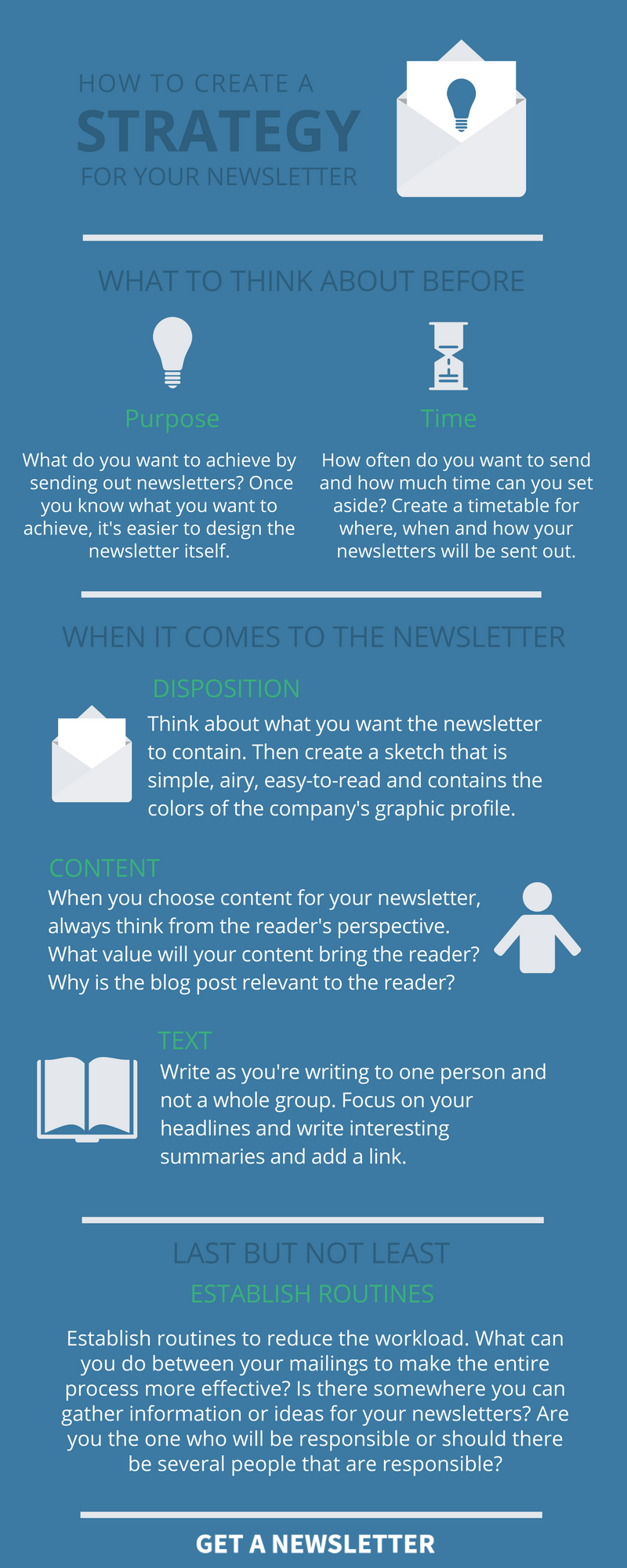When it comes to email marketing, sometimes you may feel that it is tough to get started. In a study that we made, several of the respondents mentions that it was difficult to find the time to create and send out newsletters.
When you have a plan/strategy, in this case, an email marketing strategy, it will be much easier to handle the workload. Take, for example, preparing a dinner. When you have a recipe, it’s easy to prepare the dish, compared to if you do not know what dish you want to make or what ingredients you want in the dish.
To help you find a structure/email marketing strategy you will below find an infographic that goes through all the different parts that your email marketing strategy should contain. Further down in the blog post you will also find more detailed information about the different parts.

6 parts that your email marketing strategy should contain
Purpose
What do you want to accomplish with your email marketing? What do you want the effect of your newsletters to be? Once you know what you want to achieve with the newsletter, it will be much easier to create the design for your newsletters. If you have a specific purpose, it is also easier to measure the effect of your email marketing. Your purpose could be, for example, to increase sales by a certain percentage, increase the number of visitors to the website or strengthen the relationship with your customer. Check and see if you have achieved your goals after six months or one year. If you don’t achieve your desired goals, it may be a good idea to change the strategy or the design of the newsletter.
Timetable
How often do you want to send out your newsletters? How many hours can you spend on creating and sending newsletters? If you have a timetable, it becomes easier for you to create a structure for when, where, and how your newsletter will be created and sent out. Your readers also know how often they can expect your newsletters. It is important not to create a newsletter, just because you need to send out a newsletter. If you don’t have any relevant information to send out, your subscribers will not appreciate the newsletter.
Disposition
Create a sketch of how you want the design of your newsletters to look. Is there any content that should be recurring? Do you want to have an introduction and an ending? When it comes to the dispositions of your newsletters, it’s good to keep your disposition simple, airy, easy-to-read, and in the same colors that you use on your website. Write short and interesting summaries and add a link, where people can get more information. Also, make it clear that you are the sender of the newsletter. If your subscribers do not see that the newsletter is sent by you, it may reduce the chance that your newsletter will be read.
Content
Always think from your subscriber’s perspective when you choose content for your newsletter. What do your subscribers get out of your content, and why is the article, blog post, or video relevant to them? Also, consider whether you want a specific theme for each newsletter. If you have an overall theme, your newsletter will then have a nice structure. If you have mixed news, you‘ll be more flexible in the creation and get a wider foundation to stand on. You should not be afraid to share what you know. Sharing your knowledge builds trust and creates long-term relationships. If you have 3-5 topics in each newsletter your newsletter will not contain too much information and the newsletter itself will not be too long.
Create an information bank where you can gather all the content that you want to include in your newsletters. Another tip is to create a free account at Bloglovin. There you can follow all the blogs that you are interested in and get the latest news from the different blogs in one place. If you want to find interesting articles, Buzzsumo is also a great site to use.
Text
When it comes to the actual text you should write personally and to one person, rather than to a whole group. You do not read a newsletter like you read a newspaper or a book. You focus 40% of the time you read a newsletter on the subject lines. Therefore, should you focus on your subject lines, write short and interesting summaries and add a link, for example, to an interesting blog post? When you use links in your newsletter, you will be able to see what your readers think is interesting and can create newsletters based on your subscriber’s interests. Click here to read about five methods that make you write better headlines.
When someone writes a newsletter with the aim to sell, it involves engaging and convincing the reader. You do not change a person’s opinion by persuading the person. No person likes to be persuaded and it can create a sense of discomfort. Instead of persuading – tune down the differences between your and your subscriber’s opinions. Highlight what’s new, and attractive and present a solution/concrete benefits that make the reader choose you. If you want to listen to an interesting lecture with a similar point of view, click here.
Establish routines
To make it easier for yourself, establish routines regarding how you work with your email marketing strategy. What can you do regularly between your mailings to make the entire process more effective? Do you have somewhere where you, possibly everyone at the company, can write down news or topics that you want to include in the newsletters? A special folder where all the pictures that are supposed to be in the newsletter are gathered? Are you the one that is responsible or should there be several people that are responsible? Should there be a planning meeting where you plan for future newsletters?
Leave a Reply